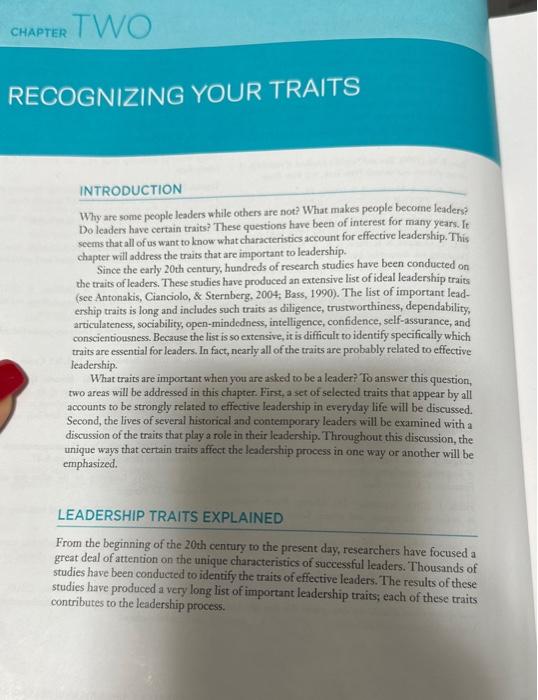



Article Reflection: Read: The third new way: A new source of leadership by Drath. How does this compare to the readings from the text. This book is about what it takes to lead. Everyone, at some time in life, is asked to be a leader, whether to lead a classroom discussion, coach a children's soccer team, or direct a fund-raising campaign. Many situations require leadership. Leadership, according to Rost (1991 ), is a mutual influence process, involving both leaders and followers. But, in every leadership situation, expectations and demands are placed upon one or more individuals to initiate and take responsibility for a decision, an event, or another need. A leader may have a high profile (e.g., an elected public official) or a low profile (e.g., a volunteer leader in Big. Brothers Big Sisters), but in every situation, leadership demands are placed on the individual who is the leader. Being a leader is challenging, exciting, and rewarding, and carries with it many responsibilities. This chapter discusses different ways of looking at leadership and their impacts on what it means to be a leader. LEADERSHIP EXPLAINED At the outset, it is important to address a basic question: What is leadenbip? Scholars who study leadership have struggled with this question for many decades and have written a great deal about the nature of leadership (Antonakis, Cianciolo, \& Sternberg, 2004; Bass, 1990; Conger \& Riggio, 2007). (See Box 1.1.) In leadership litenture, more than 100 different definitions of leadership have been identified (Rost, 1991). Despite these many definitions, a number of concepts are recognized by most people as accurately reflecting what it is to be a leader. "Leadership is a Trait" First, leadership is thought of as a trait. A trait is a distinguishing quality of an individual, and defining leadership as a trait means that each individual brings to the table certain qualities that influence the way he or she leads. Some leaders are confident, some are decisive, and still others are outgoing and sociable. Saying that leadership is a trait places a great deal of emphasis on the leader and on the leader's special gifts. It follows the INTRODUCTION Why are some people leaders while others are not? What makes people become leaders? Do leaders have certain traits? These questions have been of interest for many years. It scems that all of us want to know what characteristics account for effective leadership. This chapter will address the taits that are important to leadership. Since the early 20 th century, hundreds of research studies have been conducted on the traits of leaders. These studies have produced an extensive list of ideal leadership traits (see Antonakis, Cianciolo, \& Sternberg. 2004; Bass, 1990). The list of important leadership traits is long and includes such traits as diligence, trustworthiness, dependability, articulateness, sociability, open-mindedness, intelligence, confidence, self-assurance, and conscientiousness. Becanse the list is so extensive, it is difficult to identify specifically which traits are essential for leaders. In fact, nearly all of the traits are probably related to effective leadership. What traits are important when you are asked to be a leader? To answer this question, two areas will be addressed in this chapter. First, a set of selected trairs that appear by all accounts to be strongly related to effective leadership in everyday life will be discussed. Second, the lives of several historical and contemporary leaders will be examined with a discussion of the traits that play a role in their leadership. Throughout this discussion, the unique ways that certain trais affect the leadership process in one way or another will be emphasized. LEADERSHIP TRAITS EXPLAINED From the beginning of the 20 th cenrury to the present day, researchers have focused a great deal of attention on the unique characteristics of successful lenders. Thousinds of studies have been conducted to identify the traits of effective leaders. The results of these studies have produced a very long list of important leadership traits; each of these traits contributes to the leadership process. Where do we expect leadership to come from? Untul now people have recognized the individual leader as the obvious source of leadership. through either personal dominance or interpersonal influence. 9 ut because today's workplace challenges are so ditficult and complex. these two wellsprings of leadership cannot sufficiently address them. What is needed is a third source of leadership: people making sense and meaning of their work together. I you feel confused about seen to be a no-brainer: leaders, of leap? I often ask groups of managers and executives that ques - Although, are the source of leadership. Als answer makes sense in tion, and when 1 do, heads nod affir- many ways, it is also the cause of a matively all over the room. lot of the confusion about leadership. Those managers and executives: It is the basis for the widely held are not alone. Most of us, despite undersianding of lesdership that has being awash in advice about how to prevailed for so long. Bat it is also an about leadership itself. World we are moving into. Why? Becmuse what-used to be a In a world that is globatly interwidely shared understanding of lead- connecled; that is networked eleccrship is showing the cracks and tronically, economically, often Many things that once were agreed which differing views of life are held upon about leadership are now open. in a dynamie tension, the concept of to doubt and questioning. When peo- Ieadership from a leader is much less ple tho longer have is shaned under- workable than it was in a world ple ro longer have a shared under- standing of leadership, its practice becosines conere people stuck more or less in The confusion staris withe-minded groups, Leadership from The a basie bocomties confusing. The comiusion starts with a basie a leader still seems to make sense on question: Where do we expect leader- the surface, but it often doesn't work. ship to come from? The answer would as expected. And that's confusing











